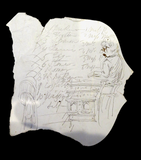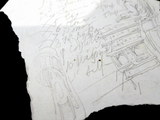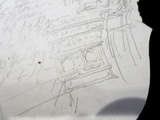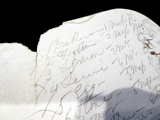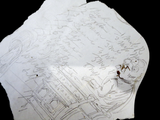A Fine And Rare Study Drawing By George Cruikshank. Finely Detailed Sketches He "Doodled" Before He Implemented The Figures Into A Finished Piece. This Has A Standing Figure With Glasses And A Numbered Grocery Shopping List. Most Studies, Like This Example, Rarely Survive. This Is Approximately 4 1/4" Wide x 4 1/4" High.
Sold By Parke-Bernet Galleries - From The Eldridge R. Johnson Collection - Part V October 29, 1946.
George Cruikshank - As Listed On Wikipedia
Cruikshank's early career was renowned for his social caricatures of English life for popular publications such as The Comic Almanack (1835-1853) and Omnibus (1842) but later in his career, his book illustrations for Charles Dickens and many other authors reached an international audience.
He created folios of prints with moralistic themes inspired by the temperance movement. The best known of these are The Bottle, 8 plates (1847), with its sequel, The Drunkard's Children, 8 plates (1848), with the ambitious work, The Worship of Bacchus, published by subscription after the artist's oil painting, now in the National Gallery, London.
For Charles Dickens, Cruikshank illustrated Sketches by Boz (1836) and Oliver Twist (1838). On December 30, 1871 Cruikshank published a letter in The Times which claimed credit for much of the plot of Oliver Twist. The letter launched a fierce controversy around who created the work. While Dickens was the author, Cruikshank developed many ideas like those that appeared in the book and it is difficult -- if not impossible -- to distinguish his concepts from those of Dickens, which were developed at the same time.
Political caricatures
Cruikshank's 60-year career began with political prints that attacked the royal family and leading politicians (in 1820 he received a royal bribe of �100 for a pledge "not to caricature His Majesty" (George III of the United Kingdom) "in any immoral situation"). His work included a personification of England named John Bull who was developed from about 1790 in conjunction with other British satirical artists such as James Gillray, and Thomas Rowlandson.
Cruikshank replaced one of his major influences, James Gillray, as England's most popular satirist. For a generation he delineated Tories, Whigs and Radicals impartially. Satirical material came to him from every public event�wars abroad, the enemies of Britain (he was highly patriotic), the frolic, among other qualities, such as the weird and terrible, in which he excelled. His hostility to enemies of Britain and a crude racism is evident in his illustrations commissioned to accompany William Maxwell's History of the Irish rebellion in 1798 (1845) where his lurid depictions of incidents in the rebellion were characterised by the simian-like portrayal of Irish rebels.
Sold By Parke-Bernet Galleries - From The Eldridge R. Johnson Collection - Part V October 29, 1946.
George Cruikshank - As Listed On Wikipedia
Cruikshank's early career was renowned for his social caricatures of English life for popular publications such as The Comic Almanack (1835-1853) and Omnibus (1842) but later in his career, his book illustrations for Charles Dickens and many other authors reached an international audience.
He created folios of prints with moralistic themes inspired by the temperance movement. The best known of these are The Bottle, 8 plates (1847), with its sequel, The Drunkard's Children, 8 plates (1848), with the ambitious work, The Worship of Bacchus, published by subscription after the artist's oil painting, now in the National Gallery, London.
For Charles Dickens, Cruikshank illustrated Sketches by Boz (1836) and Oliver Twist (1838). On December 30, 1871 Cruikshank published a letter in The Times which claimed credit for much of the plot of Oliver Twist. The letter launched a fierce controversy around who created the work. While Dickens was the author, Cruikshank developed many ideas like those that appeared in the book and it is difficult -- if not impossible -- to distinguish his concepts from those of Dickens, which were developed at the same time.
Political caricatures
Cruikshank's 60-year career began with political prints that attacked the royal family and leading politicians (in 1820 he received a royal bribe of �100 for a pledge "not to caricature His Majesty" (George III of the United Kingdom) "in any immoral situation"). His work included a personification of England named John Bull who was developed from about 1790 in conjunction with other British satirical artists such as James Gillray, and Thomas Rowlandson.
Cruikshank replaced one of his major influences, James Gillray, as England's most popular satirist. For a generation he delineated Tories, Whigs and Radicals impartially. Satirical material came to him from every public event�wars abroad, the enemies of Britain (he was highly patriotic), the frolic, among other qualities, such as the weird and terrible, in which he excelled. His hostility to enemies of Britain and a crude racism is evident in his illustrations commissioned to accompany William Maxwell's History of the Irish rebellion in 1798 (1845) where his lurid depictions of incidents in the rebellion were characterised by the simian-like portrayal of Irish rebels.







